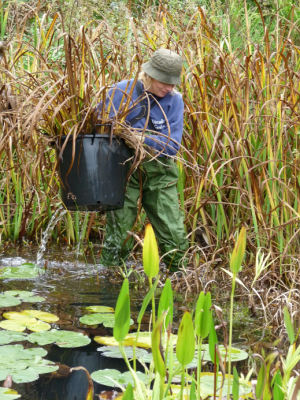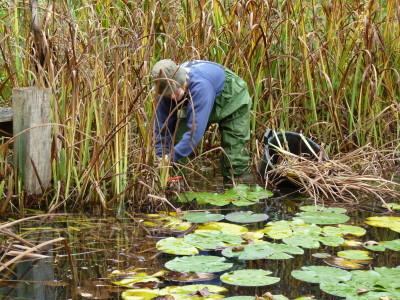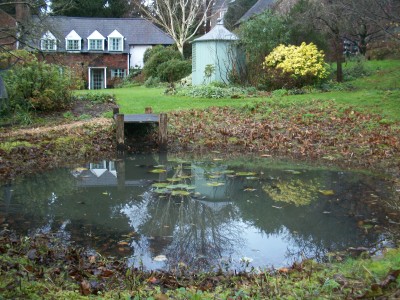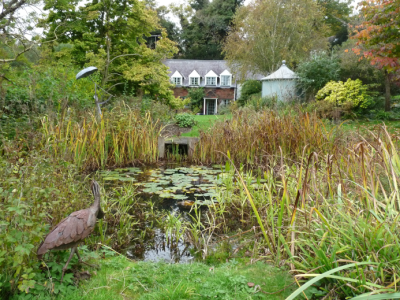The Autumn garden is a magical place, the vibrant summer hues fading,the browns and rusts of turning leaves mingling with the rich colours of late flowering perennials, there is much to be enjoyed and much work to be done.
The new eco-sensitive gardener is of course not a completely tidy one, gone are the days when every herbaceous plant the moment a brown stem appeared is cut down to the ground, instead the prairie garden movement that sprang to life in Germany has made us all appreciate the beauty of clumps of brown stems and seed heads with frost, dew and spiders webs bringing winter beauty to the garden.
Also the gardener can do much to help the wildlife of their garden over winter from the odd small pile of leaves for over wintering amphibians, to larger piles of logs and leaves for hedgehogs, sadly a much rarer visitor to must gardens, to piles of twigs and grass for insects.
But there is still some hard graft that needs to be done. Leaves cleared from the lawns and grassed areas, if you have room, keep the leaves to make into leaf mold, just one or two black bin liners full stuck behind the shed ready for use next year is worth doing. Clearing paths of flopping dying foliage and giving them a good brush and wash down to help stop them being slippery over the winter. There is still time to plant Tulip bulbs now and Lily bulbs into December.
The big autumn job and one that often gets over looked is if you have a planted pond, be it formal or informal and do not be fooled by the word ‘wildlife’ pond, as natural and balanced as it may be, it will need some maintenance and now is the time to do it. If you do nothing your wonderful pond of any size or style, packed with aquatic, marginal and bog plants, will do what nature intend and in time will go from pond to swamp from swamp to bog garden and finally to land and will be a pond with open water no more.
There is nothing for it, you will have to get down and dirty and hit the water. Depending on the depth of the pond, wellys or wadders and if it is fairly big and deep then a dirty water pump is a great bit of kit to get hold off. Over several hours it will reduce the water level exposing more of the planting and hopefully you will not have to go in over your wellys. Rubber gloves or even washing up gloves are good. For cutting I find a bluntish old bread knife on the end of a long string round the neck every bit as good and easier than gardening secateurs. Containers for putting the plant debris in, plant pots or a big bucket or garden plastic trug, but with holes in. You want something that floats and drains the water out.

If it is a sizable pond and you are going to be in it standing on the marginal planting shelves working then see if you can get a second pair of hands to help, by feeding you empty containers to fill, otherwise walking in and out of the pond is not only hard work but you will no doubt be adding more organic matter and soil into the pond.

You want to cut down all the dying down marginal plants as close to the water surface as possible if you can reach the dying leaves on floaters like water lilies as well even better. You want to remove as much organic matter as you can, to stop it falling to the bottom of the pond rotting and in time filling the pond in. Also reducing the organic matter will help to keep the water in the pond well balanced.
Once you have cut down the bog plants and as much of the marginal planting as you can reach, you should now have some bare pond edges and banks. Now If possible also reduce some of the oxygenating plants as well, a plastic garden rake is best for this running it under the water surface, pulling out what you can, moving round the pond taking one sweep out of each section of the pond, so you do not remove it all. Spread the contents of the rake on the pond banks, remove any obvious aquatic snails. Leave the contents of the rake on the banks over night to allow pond insects and the odd newt to head back into the water.

All of the pond debris should compost well unless you have some very hardy bull rushes. Do not fear about taking to much out of the pond, remember pond plants are at best vigorous and at worst dame right thugs, if very attractive ones at that.
After all this very hard work, the pond will look a little bare and perhaps very low if you have been pumping to get at the marginals,but with winter rains coming it will quickly fill up again. If you have fish and you pond is less than 1.20/1.30m deep then a couple of tennis balls for small ponds and a football for larger ponds just to stop it completely freezing over is a good idea. By spring it will be full of another years worth of fabulous marginal planting and busy with aquatic life.

